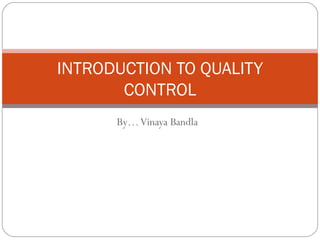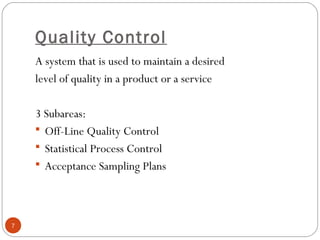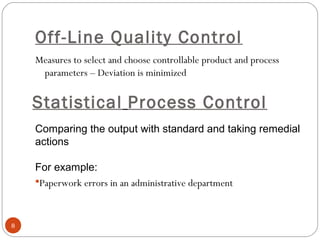Presentation new copy
- 1. INTRODUCTION TO QUALITY CONTROL ByâĶ Vinaya Bandla
- 2. Quality General : Measure of excellence or state of being free from defects and deficiencies Manufacturing : Strict and consistent adherence to measurable and verifiable standards to achieve uniformity of output that satisfies specific customer or user requirements. For example: ï§ Bike needs periodic check up!! ï§ Senior citizen needs regular health check up!! 2
- 3. Quality Characteristics ï§ Structural Characteristics ï§ Sensory Characteristics ï§ Time-oriented Characteristics ï§ Ethical Characteristics 3
- 4. Variables and Attributes Variables: Expressed on numerical scale Eg: Thickness of washers are 2+0.1 mm Attributes: Either confirming or non-confirming to a stipulated specification Eg: color of fabric , smell of perfume Defect ï§ Does not meet standards ï§ Unacceptable or defective ï§ Modern term Nonconformity 4
- 5. Specification ï§ Set of conditions and requirements ï§ Detailed description of the procedure , process ,material , product ï§ Standard may be included or referred Standard ï§ Does not meet standards ï§ Unacceptable or defective ï§ Modern term Nonconformity 5
- 6. Quality of Design ï§ Quality of Design Product or service must be designed to meet at least minimal needs of the consumer ï§ Quality of Conformance Manufactured Product or service rendered must meet the standards selected in design phase ï§ Quality of Performance How well the product functions or service performs when put to use 6
- 7. Quality Control A system that is used to maintain a desired level of quality in a product or a service 3 Subareas: ï§ Off-Line Quality Control ï§ Statistical Process Control ï§ Acceptance Sampling Plans 7
- 8. Off-Line Quality Control Measures to select and choose controllable product and process parameters â Deviation is minimized Statistical Process Control Comparing the output with standard and taking remedial actions For example: ï§Paperwork errors in an administrative department 8
- 9. On-line Statistical Process Control Information gathered about product, process or service while its functional. ï Corrective actions on real-time basis ï Brings system to acceptable state Acceptance Sampling Plans The number of items to sample and acceptance criteria of the lot, based on meeting certain stipulated conditions Eg: Batch of 500,sample size 50,acceptance no is 3 9
- 10. Quality Assurance All those planned or systematic actions necessary to provide confidence that a product will satisfy given needs Eg: The product design level by surveying the procedures used in design 10
- 11. Quality circles ï Consists of group of operators , supervisors, mangers and so on ï To improve ways to make product ï Effective productivity improvement tool ï Actively involved in decision-making process Quality Improvement Team ï Identifying feasible solutions ï Cross functional in nature-advantage ï Formation of team and its leaders ï Regular feedback on results and actions taken 11
- 12. Benefits of Quality Control ï ï ï ï ï ï 12 Improvement in the quality of products System is continually evaluated and modified Improves productivity Reduces costs on long run Lead time of producing parts and subassemblies is reduced Maintain improved environment
- 13. Thank You ByâĶ Vinaya Bandla 13













